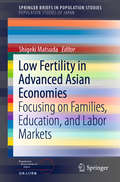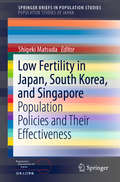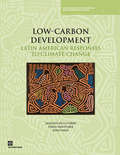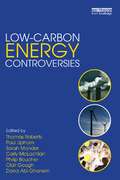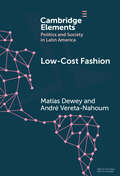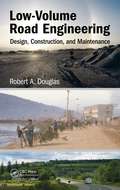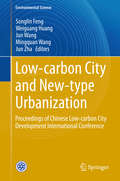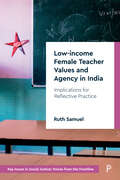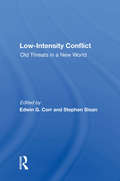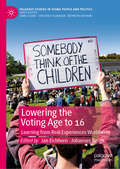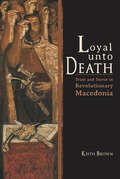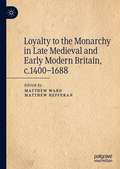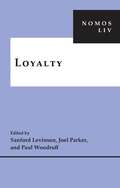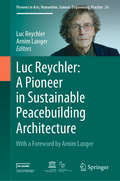- Table View
- List View
Low Carbon Transitions for Developing Countries (Routledge Studies in Low Carbon Development)
by Frauke UrbanGlobal climate change is one of the greatest challenges of our times and in order to tackle this carbon emissions need to be mitigated. China and India have recently become some of the world’s largest greenhouse gas emitters. Transitions to low carbon energy, for reducing emissions that lead to climate change, are therefore an urgent priority for China and India and at a global level. This is the first book focusing on low carbon energy transitions for emerging economies such as China and India, assessing the opportunities and barriers for transitions to renewable and low carbon energy as climate change mitigation options. It uses energy modelling to assess the China’s power sector, the economy of Beijing and rural Indian households that do not have access to electricity. The research evaluates the environmental, technical, socio-economic and policy implications of these low carbon transitions, concluding that they are possible in China and India and they can considerably contribute to climate change mitigation. This interdisciplinary book will be of interest to scholars, students, practitioners and policy-makers working in the fields of energy and development, energy policy, energy studies and modelling, climate policy, climate change mitigation, climate change and development, low carbon development, sustainable development, environment and development and environmental management.
Low Carbon Urban Infrastructure Investment in Asian Cities
by Joni Jupesta Takako WakiyamaSeveral Asian cities have already invested in initiatives to build and promote Green Cities. Owing to the limited capacity of local governments, the funding of urban infrastructure has become a critical issue. Against this background, this book explores a new funding mechanism which demands the engagement of many stakeholders, including public-private partnerships. This book offers guidance on how cities in selected countries can play a key role in the green growth agenda, by stimulating growth through smart investment in urban infrastructure such as through building a physical infrastructure, offering financial and tax incentives, and heightening society's awareness of a sustainable lifestyle.
Low Dishonest Decades: Essays & Reviews 1980-2015
by George ScialabbaEssays and reviews concentrating on politics, economics, sociology and culture. Low Dishonest Decades is George Scialabba’s fourth Pressed Wafer title. It differs from What Are Intellectuals Good For, The Modern Predicament and For the Republic in that it has a theme: Income inequality as a fundamental threat to American democracy. George continues to write clearly and well, his humanity can be felt on every page and he is always stirring the pot to provoke fresh thoughts and new ideas. Low Dishonest Decades is his most urgent book. Clinton, Trump, the alt-right, conservatives and liberals, the Koch brothers, business leaders and talking heads are missing the point—most of the important points—and George knows it. What is to be done? The place to start is by reading Low Dishonest Decades.
Low Fertility in Advanced Asian Economies: Focusing on Families, Education, and Labor Markets (SpringerBriefs in Population Studies)
by Shigeki MatsudaThis book focuses on the links between family, education, and employment systems in the Asian developed economies, proposing that these three systems and their interrelations are powerful factors causing the low fertility in Asia.The phenomenon of low fertility has been widely observed in developed countries, and the birthrate in Asian countries is among the lowest in the world. Although these countries have implemented measures to counter the falling birthrate, the expected effect has not yet been achieved. Moreover, Asia has seen a rapid decrease in the number of marriages. To promote effective countermeasures, it is necessary to clarify the factors influencing the low birthrate and decline in the number of marriages. Based on a statistical analysis of survey results mainly from Japan, South Korea, and Singapore, this book discusses several important points. First, because the family system is strong, cohabitation and children born to single mothers are not socially accepted. Further, mothers play a strong role in fulfilling expectations for children’s education. Second, the popularization of higher education and intense academic competition, which have been a driving force for rapid economic growth, have led to many parents opting to have fewer children, as the cost of education is high. Lastly, wage disparity is large and employment stability is a matter of concern. These factors increase competition within education and, in turn, make it difficult for the young generation to choose marriage. Within the employment environment, balancing work and family life is problematical, especially for women.
Low Fertility in Japan, South Korea, and Singapore: Population Policies and Their Effectiveness (SpringerBriefs in Population Studies)
by Shigeki MatsudaThis book describes the low fertility status in three developed Asian countries—Japan, South Korea, and Singapore—and outlines countermeasures for their declining birthrates. Based on the characteristics of each society, the authors discuss why their fertility rates have not yet recovered. Low fertility is a demographic phenomenon that first occurred in Europe and subsequently spread across other countries. Currently, the fertility rates in Europe are relatively stable, while those in developed Asian economies are the lowest worldwide. This may cause labor shortages and weaken their social security systems, undermining Asia’s social and economic sustainability despite its remarkable economic development. In response to low fertility, some Asian countries have implemented countermeasures: Japan has introduced measures based on childcare facilities and work–life balance. Similarly, since the mid-2000s South Korea has established countermeasures to promote a balance between work and child rearing, as well as expanded childcare services. Singapore began introducing countermeasures before the other two countries, including various advanced measures. Yet none of these countries has seen a full recovery in fertility rates. Based on a statistical analysis of survey results from the three countries, this book makes several important points. The first is that the policy has been ineffective in Japan due to a discrepancy between the needs of parents raising children and those who are the targets of the countermeasures. Second, the work–life balance and child-rearing support measures that have been promoted in Japan and South Korea have not affected the number of children that women want to have. Third, Singaporean values tend to place individual emphasis on competition with oneself (education and career status) rather than on married life. This intense competition has lowered fertility rates. To restore these rates, each country must promote policies that better address its specific issues.
Low Impact Living: A Field Guide to Ecological, Affordable Community Building (Earthscan Tools for Community Planning)
by Paul ChattertonThis book is the inspirational story of one project that shows you how you can become involved in building and running your neighbourhood. The author, co-founder of Lilac (Low Impact Living Affordable Community), along with other members of the community and the project team, explains how a group of people got together to build one of the most pioneering ecological, affordable cohousing neighbourhoods in the world. The book is a story of perseverance, vision and passion, demonstrating how ordinary people can build their own affordable, ecological community. The book starts with the clear values that motivated and guided the project’s members: sustainability, co-operativism, equality, social justice and self-management. It outlines how they were driven by challenges and concerns over the need to respond to climate change and energy scarcity, the limits of the ‘business as usual’ model of pro-growth economics, and the need to develop resources so that communities can determine and manage their own land and resources. The author’s story is interspersed with vignettes on topics such as decision making, landscaping, finance and design. The book summarises academic debates on the key issues that informed the project, and gives technical data on energy and land issues as well as practical ‘how-to’ guides on a range of issues such as designing meetings, budget planning and community agreements. Low Impact Living provides clear and easy to follow advice for community groups, practitioners, government, business and the development sector and is heavily illustrated with drawings and photographs from the architectural team.
Low-Carbon Development for Mexico
by Todd M. Johnson Claudio Alatorre Feng Liu Zayra RomoTo reduce the risk of climate change impacts it is necessary for the world to lower the carbon intensity of economic development. 'Low-Carbon Development for Mexico' estimates the net costs, greenhouse gas (GHG) emission reductions, and investment that would be needed to achieve a low-carbon scenario in Mexico to the year 2030. Among the key findings of the study are the following: Energy efficiency. Improving energy end-use efficiency in the industrial, residential, and public sectors is the least-cost option for reducing carbon emissions and can be achieved by accelerating current Mexican programs and policies. Supply efficiency and renewable energy. Mexico can lower the carbon intensity of the economy by improving the efficiency of energy supply in the electric power and petroleum industries, and by expanding the adoption of renewable energy technologies such as wind, biomass, small hydro, and geothermal. Public transport and vehicle fleet efficiency. Transport is the largest and fastest growing contributor of GHG emissions in Mexico, the majority of which comes from road transport. The greatest potential for reducing transport emissions lies with improving the quality and efficiency of urban transport, including more efficient vehicles and the design and organization of cities and public transport systems. Forestry - significant potential with large co-benefits. Measures to reduce emissions from deforestation and forest degradation (REDD), along with afforestation and commercial plantations, are among the largest GHG mitigation options in Mexico, and could provide numerous social and environmental benefits in rural areas. By undertaking a limited number of low-carbon interventions that are technologically and financially viable today, Mexico could hold carbon emissions relatively constant over the coming two decades while maintaining a vigorous rate of economic and social development. The costs of such a program would be relatively modest, but would require a range of regulatory and institutional changes to achieve, especially in the energy and transport sectors.
Low-Carbon Development: Latin American Responses to Climate Change
by John Nash Augusto De la Torre Pablo FajnzylberThis book, the companion volume to 'Low Carbon, High Growth: Latin American Responses to Climate Change', examines some of the major threats posed by climate change to the region's economies, societies, and biodiversity. It describes the patterns of greenhouse gas emissions in the Latin America and Caribbean region and in specific countries, finding that the future trajectory could be increases in emissions relative to other regions. 'Low-Carbon Development' explains why it is in the region's best interest to participate actively in global efforts to reduce emissions and what type of global climate change architecture could allow the countries to make their most effective contributions. Finally, the book lays out an agenda for domestic policies and investments to help the countries adapt to climate change while reducing their emissions profiles. It will be useful to policy makers, civil society organizations, and researchers working in climate change.
Low-Carbon Energy Controversies
by Paul Upham Clair Gough Sarah Mander Thomas Roberts Carly McLachlan Philip Boucher Dana Abi GhanemGovernments, big business and communities are coming under increased pressure to develop low carbon energy supply technologies. Within the context of the climate change debate a delicate balance has to be reached between local environmental protection and our need for reliable low carbon energy. This books brings together ten years of research conducted by the Tyndall Centre for Climate Change Research and uses a range of case studies from carbon capture and storage to on-shore wind farms to explore the complex nature of disputes between a wide variety of stakeholder groups. Topics covered include: the importance of context the relationship between risk and trust sense of place role of the media An invaluable resource for researchers and readers in local or national government, industry or community groups who wish to deepen their understanding of controversy around low carbon technology and how to overcome it.
Low-Cost Fashion: The Political Economy of Garment Production and Distribution in Latin America (Elements in Politics and Society in Latin America)
by Matías Dewey André Vereta NahoumThis Element analyses a fundamentally new regional configuration of the garment sector, covering much of South America. Based on ethnographic fieldwork and in-depth interviews with a wide range of actors, it examines two major circuits of informal production and distribution of affordable garments, both of which have emerged around the urban marketplaces of La Salada (Buenos Aires) and Feira da Madrugada (São Paulo). This Element examines a configuration characterized by (1) manufacturers who interact with customer preferences to produce low-cost fashion, (2) marketplaces that function as large garment distribution hubs, and (3) extensive distribution routes with regional reach. This Element discusses the role of creativity in informal production processes, reflects on the implications of both cases for our understanding of global value chains and informality, and provides empirical evidence on forbearance as an explanatory element for the emergence of this phenomenon.
Low-Volume Road Engineering: Design, Construction, and Maintenance
by Robert A. Douglas"Everything that sustains us – grown, mined, or drilled – begins its journey to us on a low-volume road (Long)." Defined as roads with traffic volumes of no more than 400 vehicles per day, they have enormous impacts on economies, communication, and social interaction. Low-volume roads comprise, at one end of the spectrum, farm-to-market roads, roads in developing countries, northern roads, roads on aboriginal lands and parklands; and at the other end of the spectrum, heavy haul roads for mining, oil and gas, oil sands extraction, and forestry. Low-Volume Road Engineering: Design, Construction, and Maintenance gives an international perspective to the engineering design of low-volume roads and their construction and maintenance. It is a single reference drawing from the dispersed literature. It lays out the basic principles of each topic, from road location and geometric design, pavement design, slope stability and erosion control, through construction to maintenance, then refers the reader to more comprehensive treatment elsewhere. Wherever possible, comparisons are made between the standard specifications and practices existing in the US, Canada, the UK, South Africa, Australia and New Zealand.Topics covered include the following: Road classification, location, and geometric design Pavement concepts, materials, and thickness design Drainage, erosion and sediment control, and watercrossings Slope stability Geosynthetics Road construction, maintenance, and maintenance management Low-Volume Road Engineering: Design, Construction, and Maintenance is a valuable reference for engineers, planners, designers and project managers in consulting firms, contracting firms and NGOs. It also is an essential reference in support of university courses on transportation engineering and planning, and on mining, oil and gas, and forestry infrastructure.
Low-carbon City and New-type Urbanization
by Jun Wang Weiguang Huang Mingquan Wang Songlin Feng Jun ZhaIn the face of increasingly serious resource and environmental challenges, the world has already accepted low-carbon development as the main way forward for future city construction. Chinese cities have encountered many problems during their development, including land constraints, energy shortages, traffic congestion and air pollution. For this reason, the national meeting of the Central Work Conference on Urbanization made the strategic decision to take a new approach to urbanization and indicated that in future the key features of urbanization in China will be low-carbon development and harmony between the environment and resources. This book discusses the "low-carbon city" as the new pattern of Chinese urbanization. This represents a major change and takes "intensive land use," "intelligent," "green" and "low carbon" as its key words. Low carbon will become an important future development direction for Chinese urbanization development. In the twenty-first Century in response to the global climate change, countries have started a wave of low-carbon city construction. But in China, there are still many disputes and misunderstandings surrounding the issue. Due to a lack of research, low-carbon city construction in China is still in the early stages, and while there have been successes, there have also been failures. There are complex and diverse challenges in applying low-carbon development methods in the context of today's Chinese cities. The construction of low-carbon cities requires efficient government, the technological innovation of enterprises, and professional scholars, but also efforts on the part of the public to change their daily activities. Based on the above considerations, the collection brings together experts from urban planning and design, clean-energy systems, low-carbon transportation, new types of city infrastructure and smart cities etc. , in the hope of forming some solutions for Chinese low-carbon city development.
Low-income Female Teacher Values and Agency in India: Implications for Reflective Practice (Key Issues in Social Justice)
by Ruth SamuelEducation in India concentrates on exam performance and consequently the teacher in India often acts as a disseminator of textbook material, as well as maintaining class discipline and respect. This book explores low-income female teachers' speech and syntax as a crucial resource in which agency, freedom and empowerment is enacted within a strong oral tradition in India. The book demonstrates how this socially and economically marginalised group overcome prejudices to develop relational agency and embed their authority. It shows how they establish their values and why their beliefs shape attitudes to aspiration, achievement and freedom of choice. It concludes with recommendations for policy and improvements to reflective practice in teaching.
Low-intensity Conflict: Old Threats In A New World
by Edwin G CorrThe end of the cold war does not necessarily mean the end of the social and political instability that can lead to low-intensity conflicts. This book provides fresh insights into a difficult subject by bringing together knowledgeable contributors who have the academic expertise, operational experience, and strategic perspective essential to underst
Lower Ed: The Troubling Rise of For-Profit Colleges in the New Economy
by Tressie McMillan CottomLower Ed is quickly becoming the definitive book on the fastest-growing sector of higher education at the turn of the twenty-first century: for-profit colleges. With sharp insight and deliberate acumen, Tressie McMillan Cottom―a sociologist who was once a recruiter at two for-profit colleges―expertly parses the fraught dynamics of this big-money industry. <p><p>Drawing on more than one hundred interviews with students, employees, executives, and activists, Lower Ed details the benefits, pitfalls, and real costs of the expansion of for-profit colleges. Now with a new foreword by Stephanie Kelton, economic advisor to Bernie Sanders's presidential campaign, this smart and essential book cuts to the very core of our nation's broken social contracts and the challenges we face in our divided, unequal society.
Lowering the Voting Age to 16: Learning from Real Experiences Worldwide (Palgrave Studies in Young People and Politics)
by Jan Eichhorn Johannes BerghThis book explores the consequences of lowering the voting age to 16 from a global perspective, bringing together empirical research from countries where at least some 16-year-olds are able to vote. With the aim to show what really happens when younger people can take part in elections, the authors engage with the key debates on earlier enfranchisement and examine the lead-up to and impact of changes to the voting age in countries across the globe. The book provides the most comprehensive synthesis on this topic, including detailed case studies and broad comparative analyses. It summarizes what can be said about youth political participation and attitudes, and highlights where further research is needed. The findings will be of great interest to researchers working in youth political socialization and engagement, as well as to policymakers, youth workers and activists.
Loyal Unto Death: Trust and Terror in Revolutionary Macedonia (New Anthropologies of Europe)
by Keith Brown“The story of the Macedonian Revolutionary Organization (MRO) from its rise until the Illinden Uprising of 1903 . . . a fascinating account.” —PoLARThe underground Macedonian Revolutionary Organization recruited and mobilized over 20,000 supporters to take up arms against the Ottoman Empire between 1893 and 1903. Challenging conventional wisdom about the role of ethnic and national identity in Balkan history, Keith Brown focuses on social and cultural mechanisms of loyalty to describe the circuits of trust and terror—webs of secret communications and bonds of solidarity—that linked migrant workers, remote villagers, and their leaders in common cause. Loyalties were covertly created and maintained through acts of oath-taking, record-keeping, arms-trading, and in the use and management of deadly violence.“This book is, to my mind, exactly the kind of work that needs to be done in order to understand civil wars, insurgencies, nationalism, and rebellions, and to get away from what the author rightfully critiques as ‘pidgin social science.’” —Chip Gagnon, Ithaca College“An innovative work that should inspire debate.” —Slavic Review“A subtle and compelling account of revolutionary insurgency in turn-of-the-century Macedonia. His analytical focus on loyalties, rather than identities, goes beyond critiques of nationalism in enabling powerful new understandings of the region’s histories and its continuing social dynamics.” —Jane K. Cowan, University of Sussex
Loyal to the Sky: Notes from an Activist
by Marisa HandlerCombining captivating personal memoir and astute political reportage, Marisa Handler offers a fascinating inside look at the burgeoning global justice movement through her own compelling coming-of-age story. Born in apartheid South Africa, Handler emigrated to Southern California at the age of twelve. Her gradual realization that injustice existed even in this more open, democratic society spurred a lifelong commitment to activism that would take her around the world and back again. Handler shares intimate details of her life as a global justice activist to offer a revealing perspective on what drives the movement. Tracing her own evolution as an activist, her story crisscrosses the globe, examining current sociopolitical issues from apartheid and racism to the Israeli-Palestinian conflict, corporate globalization, and the wars of the Bush administration. Along the way, Handler paints compelling portraits of the people she's encountered, shares gritty details of the sometimes-harrowing events that have changed and shaped her, and describes how she came to advocate a spiritually based, nonviolent activism as the best means for building the kind of world we wish to see.
Loyalties
by Raymond WilliamsWhat is loyalty? What is treachery? What does it mean to find that one of your friends is a spy? Loyalties traces the fortunes of a group of friends, some from the Welsh valleys, some from Cambridge, from the Spanish Civil War to the 1984 miners' strike, combining the tension of a first-class thriller with a brilliant analysis of our age.
Loyalties: A Son's Memoir
by Carl BernsteinThe events that shaped the author's childhood and led to the persecution of his parents during the McCarthy era.
Loyalty and Liberty: American Countersubversion from World War 1 to the McCarthy Era
by Alex GoodallLoyalty and Liberty offers the first comprehensive account of the politics of countersubversion in the United States prior to the McCarthy era. Alex Goodall traces the course of American countersubversion over the first half of the twentieth century, culminating in the rise of McCarthyism and the Cold War. This sweeping study explores how antisubversive fervor was dampened in the 1920s in response to the excesses of World War I, transformed by the politics of antifascism in the Depression era, and rekindled in opposition to Roosevelt's ambitious New Deal policies in the later 1930s and 1940s. Varied interest groups such as business tycoons, Christian denominations, and Southern Democrats as well as the federal government pursued their own courses, which alternately converged and diverged, eventually consolidating into the form they would keep during the Cold War. Rigorous in its scholarship yet accessible to a wide audience, Goodall's masterful study shows how the opposition to radicalism became a defining ideological question of American life.
Loyalty in America
by John H. SchaarThis title is part of UC Press's Voices Revived program, which commemorates University of California Press’s mission to seek out and cultivate the brightest minds and give them voice, reach, and impact. Drawing on a backlist dating to 1893, Voices Revived makes high-quality, peer-reviewed scholarship accessible once again using print-on-demand technology. This title was originally published in 1957.
Loyalty to the Monarchy in Late Medieval and Early Modern Britain, c.1400-1688
by Matthew Ward Matthew HefferanThis book explores the place of loyalty in the relationship between the monarchy and their subjects in late medieval and early modern Britain. It focuses on a period in which political and religious upheaval tested the bonds of loyalty between ruler and ruled. The era also witnessed changes in how loyalty was developed and expressed. The first section focuses on royal propaganda and expressions of loyalty from the gentry and nobility under the Yorkist and early Tudor monarchs, as well as the fifteenth-century Scottish monarchy. The chapters illustrate late-medieval conceptions of loyalty, exploring how they manifested themselves and how they persisted and developed into early modernity. Loyalty to the later Tudors and early Stuarts is scrutinised in the second section, gauging the growing level of dissent in the build-up to the British Civil Wars of the seventeenth century. The final section dissects the role that the concept of loyalty played during and after the Civil Wars, looking at how divergent groups navigated this turbulent period and examining the ways in which loyalty could be used as a means of surviving the upheaval.
Loyalty: NOMOS LIV (NOMOS - American Society for Political and Legal Philosophy #14)
by Paul Woodruff Sanford Levinson Joel ParkerFew topics are more ubiquitous in everyday life and, at the same time, more controversial in practice, than that of one’s moral obligation to loyalty. Featuring essays by scholars working in a variety of subjects from law to psychology, Loyalty presents diverse perspectives on dilemmas posed by potential conflicts between loyalties to specific institutions or professional roles and more universalistic conceptions of moral duty. The volume begins with a philosophical exploration of theories of loyalty, both Eastern and Western, then moves to examine several problematic situations in which loyalty is often a factor: partisan politics, the armed forces, and lawyer-client relationships. A fair and balanced analysis from a wide range of disciplinary and normative viewpoints, Loyalty infuses new life into an oft-tread avenue of scholarly inquiry. Contributors: Ryan K. Balot, Paul O. Carrese, Yasmin Dawood, Bernard Gert, Kathleen M. Higgins, Sanford Levinson, Daniel Markovits, Lynn Mather, Russell Muirhead, Nancy Sherman, Paul Woodruff
Luc Reychler: A Pioneer in Sustainable Peacebuilding Architecture (Pioneers in Arts, Humanities, Science, Engineering, Practice #24)
by Arnim Langer Luc ReychlerThis book provides a unique personal perspective on the field of peace research. It not only highlights Luc Reychler’s significant contributions to the theory and praxis of sustainable peacebuilding, but also offers important reflections on the evolution of peace research as an independent discipline. The central concept of this book – and of Reychler’s academic career, for that matter – is sustainable peacebuilding architecture. Reychler introduced this concept in order to draw attention to the architectural principles and considerations that have to be addressed in sustainable peacebuilding processes. Reychler’s work on sustainable peacebuilding architecture has been groundbreaking and has not lost any of its relevance in the twenty-first century. By bringing together Reychler’s seminal texts on sustainable peacebuilding architecture, the current book aims to offer academics, students and policymakers an essential guide to understanding, studying and applying this crucial concept.• Provides a unique personal view of the development of peace research• Lists the necessary building blocks for sustainable peacebuilding• Offers tools for monitoring and evaluating interventions• Discusses the scientific nature and often provocative findings of peace research • Discusses ten lessons learned and the future (Peace Research III)



